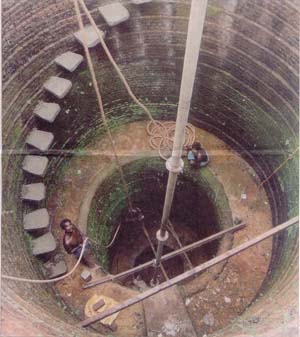- Shivani Thakkur
March 22 was celebrated, as WORLDWATER DAY .The task was to highlight merits of rainwater harvesting and save us from future water problems.
 Our country is interspersed by rivers. Yet, we face water shortage not only in urban areas but also rural areas. The population growth, loss of green cover, lack of rains, abandoning ancient techniques of water conservation have
all resulted in this crisis. In urban India where water supply is less than amount required lot of it is wasted in transit. Bad supply links has led to water shortage and problem is solved only by water tankers or bore wells. The adverse effect of bore wells
results in ground water depletion. The worst effect is that water table never gets replenished because of lack of rains and also because there are no means of collecting it. In rural areas tube wells rule where there is no water supply. This results in water
crisis.
Our country is interspersed by rivers. Yet, we face water shortage not only in urban areas but also rural areas. The population growth, loss of green cover, lack of rains, abandoning ancient techniques of water conservation have
all resulted in this crisis. In urban India where water supply is less than amount required lot of it is wasted in transit. Bad supply links has led to water shortage and problem is solved only by water tankers or bore wells. The adverse effect of bore wells
results in ground water depletion. The worst effect is that water table never gets replenished because of lack of rains and also because there are no means of collecting it. In rural areas tube wells rule where there is no water supply. This results in water
crisis.
The worst part is that people have abandoned age-old tradition of maintaining wells and ponds. This results in deposition of silt, which in turn dries up the water sources. To combat our water shortage, we have to recharge the ground
water. We have to go back to traditional method of conserving water. Since our climate has changed, rainfall has dwindled and rivers dried up; our only hope is to conserve and preserve every precious drop of drinkable water. Water harvesting can play a major
role in this. And people have realized its potential. In urban areas, the state government has passed laws that all new buildings are to have water-harvesting units. Many colonies have adopted this and have been able to raise the ground water table. The existences
of old baolis in and around Delhi are being desilted. Although a lot of work is required, it is a step in the right direction.
In rural areas also work has started. In Gujarat where drought prevailed, check dams were made. At the time of rains water collected helped them to ride the tide. Similarly in Kerala in Kasargod district, ‘Surungam”or tunnels are built
through hillocks. These Surungam are horizontal wells where water seeps in from sides. The water collected is carried through pipes into tanks outside from where it is redirected for domestic use. These have helped in ensuring adequate water supply. These
various techniques like zings in Ladakh,kuls and naulas in Himachal and Uttranchal, bamboo drip irrigation baolis can help us with our water crisis all over the country. All that is needed is a little ingenuity on our parts.
( The telling picture by Bijoy Ghosh appeared in “The Hindu”)